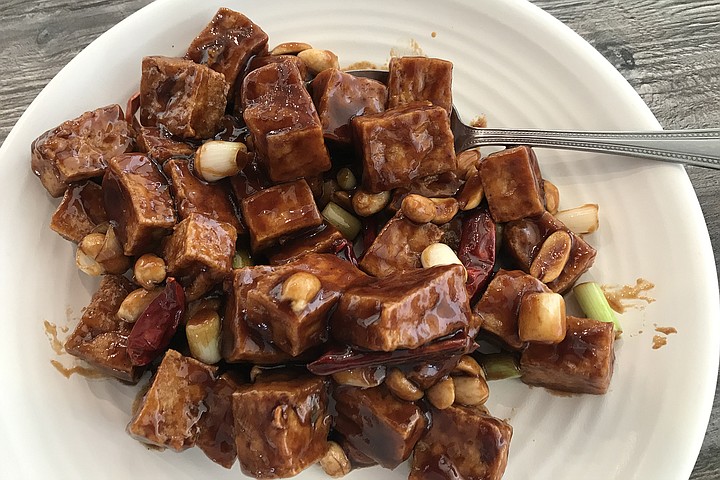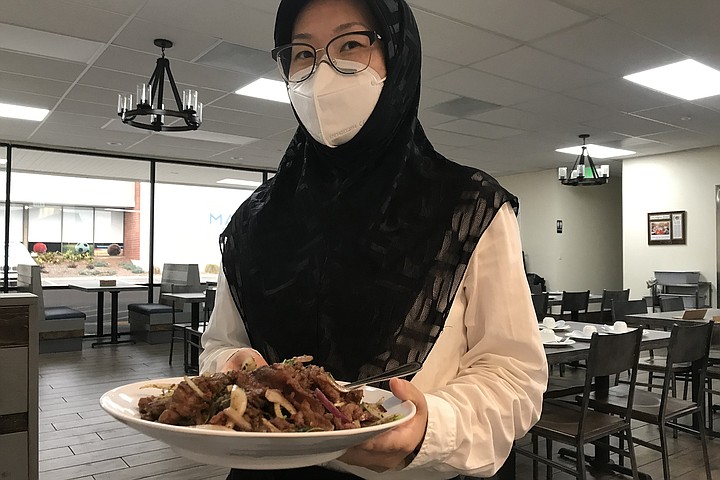 Facebook
Facebook
 X
X
 Instagram
Instagram
 TikTok
TikTok
 Youtube
Youtube

“OK. What else?”
“OK. What else?”
“OK. What else?”
The gal’s taking a food order at max speed over the phone. She reads all the items back. “OK. Xié xié (thank you)!”
She clacks her way back to the kitchen.
Pretty soon she reappears with my plate of kung pao tofu. Hmm. Looks fine. Just not sure if it’s genuine Uyghur food.
Uyghur? The Muslim people of western China. The ones being put in “re-education camps.”

Because now I’ve found these guys, I’m interested: what kind of food do Chinese Muslims eat? And specially the Uyghurs (“We-gurs”) in Xinjiang, China’s “Wild West?”
Actually, I didn’t know that’s what I was looking for till I spotted the sign, “Ma’s House,” yesterday. The name sounded so homey. And then I noticed big Chinese characters. So “Ma” doesn’t mean “Mama,” it’s a surname. Usually means “Horse.” Also, forget burgers. We’re probably looking at a ton of Americanized Chinese dishes like orange chicken or kung pao chicken.
Then, close up, you see the sign. “Chinese Halal.” Aha! Chinese Muslim food!
Now I’ve got to venture in. Inside’s a large plain place with a little reception area. Rubber tree plants, fountains, swirling Arabic lettering on plaques, a certification by the Halal Board of San Diego, and a sign saying “In this house, we laugh a lot, we try our best... we hug often, we make mistakes, we never give up, we always forgive... but above all, we love.”

Nice. So I order the kung pao tofu. It’s pretty much tofu chunks plus kung pao sauce, plus peanuts and green onions. Cost, $11.95. Not bad. My problem is you can always taste the tofu, and I ain’t totally into tofu. But 24 hours later, as it happens, I’m jumping off the 44 again. Because now I know more. This morning, I bumped into my friend Jacob, who has been to China many times.
“The thing about Uyghur,” he says, “is they weren’t originally Chinese. They moved in from the west. Kyrgyzstan, Tajikistan. The Stans! Think Silk Road. They brought their middle eastern food with them. Hand-pulled noodles, lamb, kawap (kabobs), naan (tandoor-baked bread), manta (that’s their dumplings), and polows, which is their take on pilaf. So Xinjiang is a real mixing ground. And if you’re going back, don’t forget they do cold dishes like beef tendons. Ah! Tendons! Addicting.”
Tendons? Really? Whatever, today it’s Jia who is here to take customers’ orders. She’s dressed in this light black silk scarf over her head, and a kind of decorated shoulder covering, also black, a Chinese take on the hijab. Her bright, intelligent eyes shine through the standardizing outfit.

“I am Muslim,” she says, “but I normally don’t wear this. The owners ask me to.”
She leaves a big long menu. Items like Dim Sum (10 beef dumplings, $9.95), shrimp fried rice ($11.95), to Three Flavors sizzling rice soup ($12.95). “Warm pots” look really interesting, in a comfort food way. Like beef stew warm pot, or ox-haslets warm pot. “Haslets?” Turn out to be like entrails. Organs, heart, all the messy stuff. Problem is, they’re made to feed 6-12 people. The smaller pot of ox haslets goes for $20.95. The larger lamb stew warm pot costs $29.95.
But with Jacob’s words ringing in my ears, I try to stick to “Western” dishes, meaning western Chinese dishes, from like Xinjiang, where the Beijing authorities’ current rounding up of so many Uyghurs for “re-education” is horrifying people worldwide.
I ask Jia if they have food from the Muslim west of China. “I am from Harbin, in the north of China, far away from Xinjiang. But Muslim people love lamb, and always with cumin. Also Ma’s specialty, noodles chow mein. Every Chinese Muslim, including Uyghur, loves Three Flavors Dough Sliced Chow Mein ($14.50). And not just Muslims. We have 56 different ethnic nationalities in China.”

Pretty sure the “dough sliced” is cut noodles, hand pulled at this location.
Boy. Decisions. A little at sea here. I ask people at a nearby table. The Sayed family, from Pakistan. They’re sharing orange chicken ($14.50), beef with green onions ($14.95), shrimp chow mein ($12.50), and chicken chow mein ($11.50). Hmm. All very nice, but nothing that says “Uyghur.”
I narrow my choice down to lamb - gotta have lamb - stir fried and with plenty of cumin ($15.95), because Jia says it’s real “western.” I also ask about Jacob’s tendons. “People become total devotees to a good plate of beef tendons,” Jacob said.
So I end up with lamb plus a plate of cold spicy beef tendon ($10.95).
The lamb is great. Fried slices with onions, cilantro, and of course, cumin laid richly on. It gives out an earthy, sweet, spicy, slightly mushroomy flavor.
The tendons? Yes, they take a little getting used to. They are slices, with a slippery gelatin-ish texture about them. But once you start in, Jacob’s right. You just can’t stop. They have a deep savory taste with a minty add of cilantro leaves, plus — is that soy? Garlic? Ginger? All three, for sure. And is that a prickle of pepper in there too?
This is a first for me. Don’t think I’ve ever eaten tendon before. And it makes great contrast with the lamb. Wow. Something new!
So yes, as far as Chinese food, this is different. I guess the food reflects the collision of Chinese and Middle Eastern cultures they’ve got going on out there in China’s west. (“Xinjiang” means “New Frontier.”) And yes, Ma’s House might be a good place to start learning about it, one tendon at a time.


“OK. What else?”
“OK. What else?”
“OK. What else?”
The gal’s taking a food order at max speed over the phone. She reads all the items back. “OK. Xié xié (thank you)!”
She clacks her way back to the kitchen.
Pretty soon she reappears with my plate of kung pao tofu. Hmm. Looks fine. Just not sure if it’s genuine Uyghur food.
Uyghur? The Muslim people of western China. The ones being put in “re-education camps.”

Because now I’ve found these guys, I’m interested: what kind of food do Chinese Muslims eat? And specially the Uyghurs (“We-gurs”) in Xinjiang, China’s “Wild West?”
Actually, I didn’t know that’s what I was looking for till I spotted the sign, “Ma’s House,” yesterday. The name sounded so homey. And then I noticed big Chinese characters. So “Ma” doesn’t mean “Mama,” it’s a surname. Usually means “Horse.” Also, forget burgers. We’re probably looking at a ton of Americanized Chinese dishes like orange chicken or kung pao chicken.
Then, close up, you see the sign. “Chinese Halal.” Aha! Chinese Muslim food!
Now I’ve got to venture in. Inside’s a large plain place with a little reception area. Rubber tree plants, fountains, swirling Arabic lettering on plaques, a certification by the Halal Board of San Diego, and a sign saying “In this house, we laugh a lot, we try our best... we hug often, we make mistakes, we never give up, we always forgive... but above all, we love.”

Nice. So I order the kung pao tofu. It’s pretty much tofu chunks plus kung pao sauce, plus peanuts and green onions. Cost, $11.95. Not bad. My problem is you can always taste the tofu, and I ain’t totally into tofu. But 24 hours later, as it happens, I’m jumping off the 44 again. Because now I know more. This morning, I bumped into my friend Jacob, who has been to China many times.
“The thing about Uyghur,” he says, “is they weren’t originally Chinese. They moved in from the west. Kyrgyzstan, Tajikistan. The Stans! Think Silk Road. They brought their middle eastern food with them. Hand-pulled noodles, lamb, kawap (kabobs), naan (tandoor-baked bread), manta (that’s their dumplings), and polows, which is their take on pilaf. So Xinjiang is a real mixing ground. And if you’re going back, don’t forget they do cold dishes like beef tendons. Ah! Tendons! Addicting.”
Tendons? Really? Whatever, today it’s Jia who is here to take customers’ orders. She’s dressed in this light black silk scarf over her head, and a kind of decorated shoulder covering, also black, a Chinese take on the hijab. Her bright, intelligent eyes shine through the standardizing outfit.

“I am Muslim,” she says, “but I normally don’t wear this. The owners ask me to.”
She leaves a big long menu. Items like Dim Sum (10 beef dumplings, $9.95), shrimp fried rice ($11.95), to Three Flavors sizzling rice soup ($12.95). “Warm pots” look really interesting, in a comfort food way. Like beef stew warm pot, or ox-haslets warm pot. “Haslets?” Turn out to be like entrails. Organs, heart, all the messy stuff. Problem is, they’re made to feed 6-12 people. The smaller pot of ox haslets goes for $20.95. The larger lamb stew warm pot costs $29.95.
But with Jacob’s words ringing in my ears, I try to stick to “Western” dishes, meaning western Chinese dishes, from like Xinjiang, where the Beijing authorities’ current rounding up of so many Uyghurs for “re-education” is horrifying people worldwide.
I ask Jia if they have food from the Muslim west of China. “I am from Harbin, in the north of China, far away from Xinjiang. But Muslim people love lamb, and always with cumin. Also Ma’s specialty, noodles chow mein. Every Chinese Muslim, including Uyghur, loves Three Flavors Dough Sliced Chow Mein ($14.50). And not just Muslims. We have 56 different ethnic nationalities in China.”

Pretty sure the “dough sliced” is cut noodles, hand pulled at this location.
Boy. Decisions. A little at sea here. I ask people at a nearby table. The Sayed family, from Pakistan. They’re sharing orange chicken ($14.50), beef with green onions ($14.95), shrimp chow mein ($12.50), and chicken chow mein ($11.50). Hmm. All very nice, but nothing that says “Uyghur.”
I narrow my choice down to lamb - gotta have lamb - stir fried and with plenty of cumin ($15.95), because Jia says it’s real “western.” I also ask about Jacob’s tendons. “People become total devotees to a good plate of beef tendons,” Jacob said.
So I end up with lamb plus a plate of cold spicy beef tendon ($10.95).
The lamb is great. Fried slices with onions, cilantro, and of course, cumin laid richly on. It gives out an earthy, sweet, spicy, slightly mushroomy flavor.
The tendons? Yes, they take a little getting used to. They are slices, with a slippery gelatin-ish texture about them. But once you start in, Jacob’s right. You just can’t stop. They have a deep savory taste with a minty add of cilantro leaves, plus — is that soy? Garlic? Ginger? All three, for sure. And is that a prickle of pepper in there too?
This is a first for me. Don’t think I’ve ever eaten tendon before. And it makes great contrast with the lamb. Wow. Something new!
So yes, as far as Chinese food, this is different. I guess the food reflects the collision of Chinese and Middle Eastern cultures they’ve got going on out there in China’s west. (“Xinjiang” means “New Frontier.”) And yes, Ma’s House might be a good place to start learning about it, one tendon at a time.